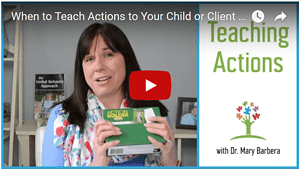Many professionals and parents struggle with what to teach once a child has dozens or hundreds of single words. So today I’m going to talk about what I recommend next, which is teaching actions and teaching verbs to children with autism.
Many professionals and parents jump to carrier phrases as soon as a child can request a few single words and I talk about why I don’t recommend that in a recent blog. But once your child or client does mand and tact for dozens or hundreds of items, there are other things you can teach. So today I want to talk to you about what I recommend, which is teaching actions to children with autism.
When to start learning actions and verbs?
Actions should only be taught if a child has mastered all the prerequisite skills, and teaching actions are level two and level three VB-MAPP skills, which are intermediate learner skills. There are two main ways to teach actions, ongoing actions and using picture cards. I recommend actually starting with ongoing actions with a couple of common actions, such as clapping. So when we teach ongoing actions we can do it receptively, “Show me clapping,” and then the child can show clapping, and then we can also have them tact the action, “What am I doing?” “Clapping.”
What actions and verbs to start with?
Now we never want to teach one action or one target per program, we want to build conditional discrimination right away. So, some other actions might be clapping, waving, knocking, those are all good, simple actions. Kissing, hugging, are a little bit difficult because we don’t necessarily want to teach blowing a kiss, it’s not appropriate for children to be kissing their therapist or their teachers. So we want to start with very simple actions that we can do readily. Another good action is eating, another basic action, but we don’t really want to pretend to eat because that’s kind of abstract. So I think clapping, knocking, and waving are all good actions to start with. So we want to do that both receptively, “Show me knocking,” as well as, “What am I doing?” and have the child label knocking, if they can speak.
About action cards
And then in terms of teaching verbs to children with autism with action cards, we want to get action cards that have not just one exemplar of clapping. And these action cards are called the Action Builder Cards, you can get them on Amazon or Different Roads to Learning, and they were actually created by Rosemary Griffin, who is a speech and language pathologist for 15 years as well as a behavior analyst for the past five or six years. Rosemary is in my online community, she has taken my online courses, and she has created these wonderful cards, which have, for instance, blowing. There are several cards, there’s blowing a kiss, there’s blowing bubbles, there’s blowing out the candles. And on the back also reads, “Blowing. Kiss. Blowing a kiss. The boy is blowing a kiss.” Great pictures, a multitude of objects that they’re blowing, there’s several actions here. So I would highly recommend these cards, she created these cards because there really weren’t great action cards on the market and she saw a big need. So, I would recommend those action cards.
But at the same time, you do want to start with the basics, you don’t want to be combining sentences before the child’s ready. Start with just the action, just washing, get several actions with just washing, brushing, and then there are other ways to build two- and three-word utterances. But if you’re not careful, things can get really rote and really messy, quickly. So I would start with ongoing, so clapping, knocking, and waving. And then I would try to generalize those to different people doing it, on these action cards, and then I would expand to other actions. Some actions are easier than others and more developmentally appropriate, and Dr. Mark Sundberg has a verb list on avbpress.com that provides a guide to know which actions are easiest and which to teach first.
Obviously, this is a quick overview and much more information is needed to truly teach actions well. You need information about assessing, planning, and programming, and I go into much more in-depth explanation of all of this in my online courses and membership. But you can start revamping your child or client’s program today by going to marybarbera.com/join for my three-step new guide, which will get you started in revamping and learning more about my philosophy and how to program easily and program for kids both at home and at school.
I hope you enjoyed this little lesson on teaching verbs to children with autism, and I will see you next week.







